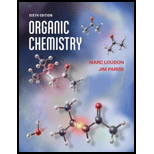
Organic Chemistry
6th Edition
ISBN: 9781936221349
Author: Marc Loudon, Jim Parise
Publisher: W. H. Freeman
expand_more
expand_more
format_list_bulleted
Question
Chapter 9, Problem 9.59AP
Interpretation Introduction
Interpretation:
The compounds that are formed when the insecticide chlordane is exposed to alkaline conditions are to be stated.
Concept introduction:
An
All these reactions take place in the presence of basic compounds but in case of SN1 and SN2 reactions, those basic compounds are termed as nucleophiles.
Expert Solution & Answer
Want to see the full answer?
Check out a sample textbook solution
Students have asked these similar questions
(SE EX 2) Problems 8-11, can you please explain them to me in detail and color-code anything if necessary?
(ME EX2) Problems 15-16 Could you please explain problems 15 through 16 to me in detail, step by step? Thank you so much! If necessary, please color-code them for me.
1.)show any electrophilic aromatic substitution, identify the electriphile, nucleophile and transition state
Chapter 9 Solutions
Organic Chemistry
Ch. 9 - Prob. 9.1PCh. 9 - Prob. 9.2PCh. 9 - Prob. 9.3PCh. 9 - Prob. 9.4PCh. 9 - Prob. 9.5PCh. 9 - Prob. 9.6PCh. 9 - Prob. 9.7PCh. 9 - Prob. 9.8PCh. 9 - Prob. 9.9PCh. 9 - Prob. 9.10P
Ch. 9 - Prob. 9.11PCh. 9 - Prob. 9.12PCh. 9 - Prob. 9.13PCh. 9 - Prob. 9.14PCh. 9 - Prob. 9.15PCh. 9 - Prob. 9.16PCh. 9 - Prob. 9.17PCh. 9 - Prob. 9.18PCh. 9 - Prob. 9.19PCh. 9 - Prob. 9.20PCh. 9 - Prob. 9.21PCh. 9 - Prob. 9.22PCh. 9 - Prob. 9.23PCh. 9 - Prob. 9.24PCh. 9 - Prob. 9.25PCh. 9 - Prob. 9.26PCh. 9 - Prob. 9.27PCh. 9 - Prob. 9.28PCh. 9 - Prob. 9.29PCh. 9 - Prob. 9.30PCh. 9 - Prob. 9.31PCh. 9 - Prob. 9.32PCh. 9 - Prob. 9.33PCh. 9 - Prob. 9.34PCh. 9 - Prob. 9.35PCh. 9 - Prob. 9.36PCh. 9 - Prob. 9.37PCh. 9 - Prob. 9.38PCh. 9 - Prob. 9.39PCh. 9 - Prob. 9.40PCh. 9 - Prob. 9.41PCh. 9 - Prob. 9.42PCh. 9 - Prob. 9.43PCh. 9 - Prob. 9.44APCh. 9 - Prob. 9.45APCh. 9 - Prob. 9.46APCh. 9 - Prob. 9.47APCh. 9 - Prob. 9.48APCh. 9 - Prob. 9.49APCh. 9 - Prob. 9.50APCh. 9 - Prob. 9.51APCh. 9 - Prob. 9.52APCh. 9 - Prob. 9.53APCh. 9 - Prob. 9.54APCh. 9 - Prob. 9.55APCh. 9 - Prob. 9.56APCh. 9 - Prob. 9.57APCh. 9 - Prob. 9.58APCh. 9 - Prob. 9.59APCh. 9 - Prob. 9.60APCh. 9 - Prob. 9.61APCh. 9 - Prob. 9.62APCh. 9 - Prob. 9.63APCh. 9 - Prob. 9.64APCh. 9 - Prob. 9.65APCh. 9 - Prob. 9.66APCh. 9 - Prob. 9.67APCh. 9 - Prob. 9.68APCh. 9 - Prob. 9.69APCh. 9 - Prob. 9.70APCh. 9 - Prob. 9.71APCh. 9 - Prob. 9.72APCh. 9 - Prob. 9.73APCh. 9 - Prob. 9.74APCh. 9 - Prob. 9.75APCh. 9 - Prob. 9.76APCh. 9 - Prob. 9.77APCh. 9 - Prob. 9.78APCh. 9 - Prob. 9.79APCh. 9 - Prob. 9.80APCh. 9 - Prob. 9.81APCh. 9 - Prob. 9.82APCh. 9 - Prob. 9.83APCh. 9 - Prob. 9.84APCh. 9 - Prob. 9.85APCh. 9 - Prob. 9.86APCh. 9 - Prob. 9.87AP
Knowledge Booster
Similar questions
- (SE EX 2) Problems 15-16, can you please explain them to me in detail and color-code anything if necessary?arrow_forward(ME EX2) Can you please explain problems to me in detail, step by step? Thank you so much! If needed color code them for me.arrow_forward(SE EX 2) Problems 1-3, can you please explain them to me in detail and color code anything if needed.arrow_forward
- (SE EX 2) Problems can you please explain them to me in detail and color-code anything if necessary?arrow_forward(SE EX 2) Problems can you please explain them to me in detail and color-code anything if necessary?arrow_forward(ME EX2) Prblms 5-7 Can you please explain problems 5-7 to me in detail, step by step? Thank you so much! If needed color code them for me.arrow_forward
- Please help me understand how to predict 4-8, using the chemicals and formula equations, and ions. Is seems like a lot but that basically what I need help understanding, please! Thank you in advance. P.S - keep seeing people to reach out in the comments if I had additional questions, but I don't see one???arrow_forward(ME EX2) Problems Could you please explain problems to me in detail, step by step? Thank you so much! If necessary, please color-code them for me.arrow_forward(SE EX 2) Problems can you please explain them to me in detail and color-code anything if necessary?arrow_forward
- (SE EX 2) Problems 4-7, can you please explain them to me in detail and color-code anything if necessary?arrow_forwardCan you explain problems 20 - 25 on here (step by step) and in detail for me pleasearrow_forward(ME EX2) Can you please explain problems to me in detail, step by step? Thank you so much! If needed color code them for me.arrow_forward
arrow_back_ios
SEE MORE QUESTIONS
arrow_forward_ios
Recommended textbooks for you
 Chemistry for Today: General, Organic, and Bioche...ChemistryISBN:9781305960060Author:Spencer L. Seager, Michael R. Slabaugh, Maren S. HansenPublisher:Cengage Learning
Chemistry for Today: General, Organic, and Bioche...ChemistryISBN:9781305960060Author:Spencer L. Seager, Michael R. Slabaugh, Maren S. HansenPublisher:Cengage Learning Organic And Biological ChemistryChemistryISBN:9781305081079Author:STOKER, H. Stephen (howard Stephen)Publisher:Cengage Learning,
Organic And Biological ChemistryChemistryISBN:9781305081079Author:STOKER, H. Stephen (howard Stephen)Publisher:Cengage Learning, General, Organic, and Biological ChemistryChemistryISBN:9781285853918Author:H. Stephen StokerPublisher:Cengage Learning
General, Organic, and Biological ChemistryChemistryISBN:9781285853918Author:H. Stephen StokerPublisher:Cengage Learning

Chemistry for Today: General, Organic, and Bioche...
Chemistry
ISBN:9781305960060
Author:Spencer L. Seager, Michael R. Slabaugh, Maren S. Hansen
Publisher:Cengage Learning

Organic And Biological Chemistry
Chemistry
ISBN:9781305081079
Author:STOKER, H. Stephen (howard Stephen)
Publisher:Cengage Learning,

General, Organic, and Biological Chemistry
Chemistry
ISBN:9781285853918
Author:H. Stephen Stoker
Publisher:Cengage Learning